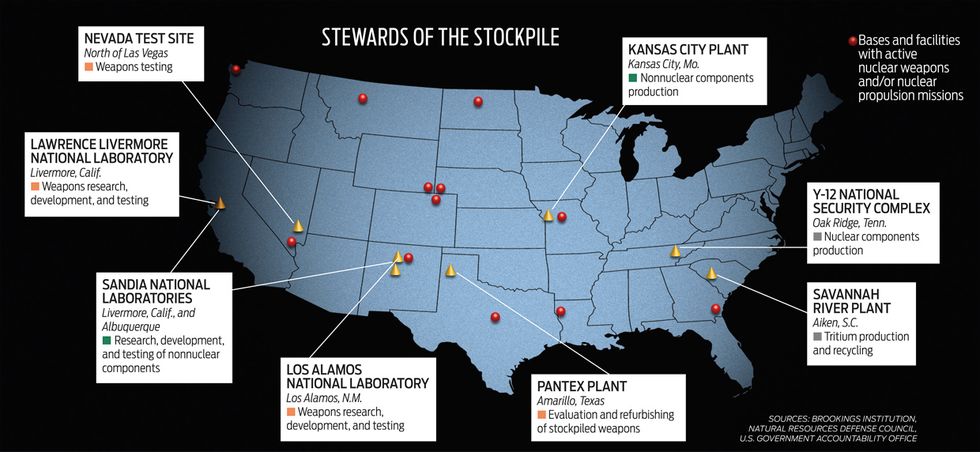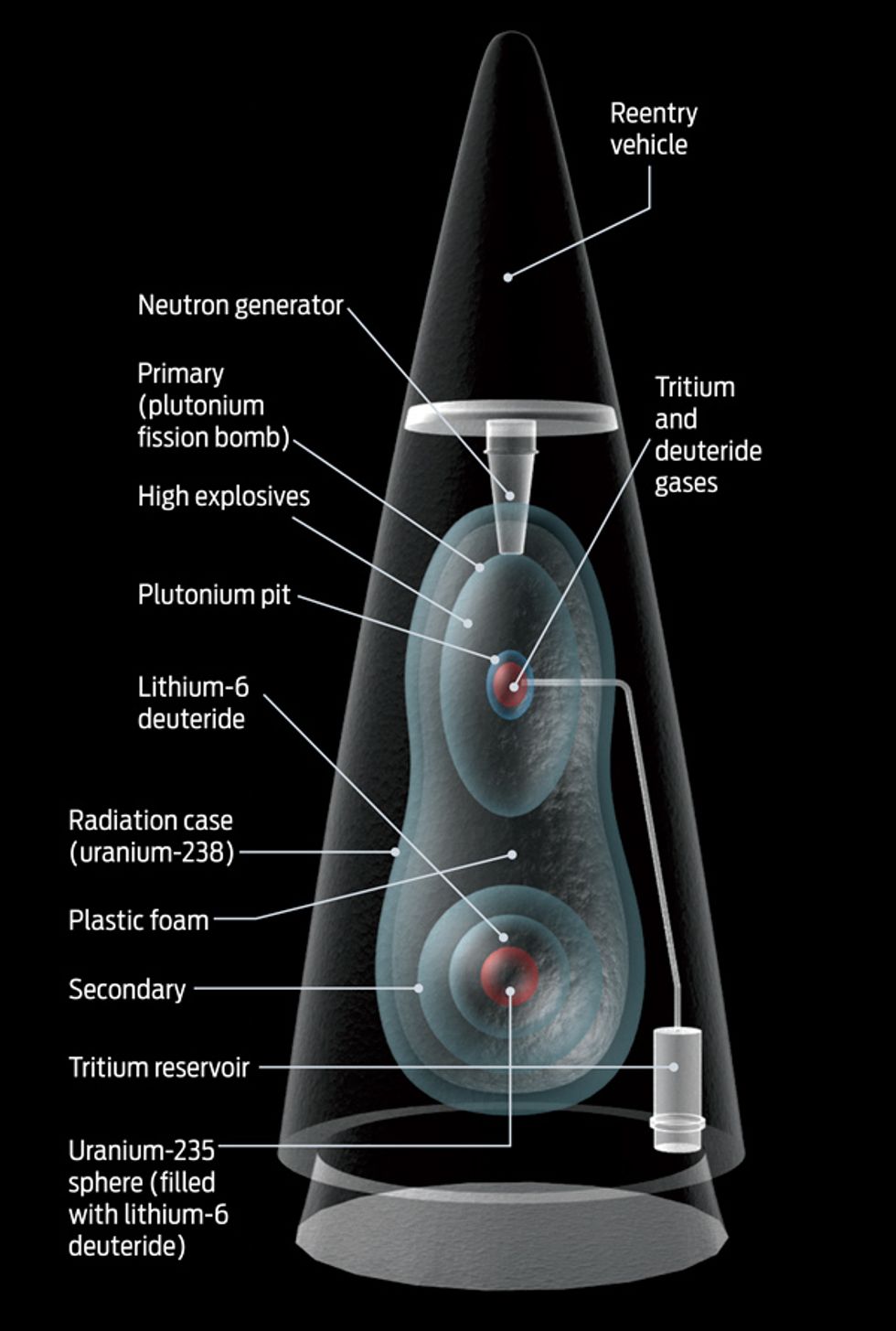What About The Nukes?
The U.S. nuclear stockpile is showing its age, but building new warheads isn’t the solution
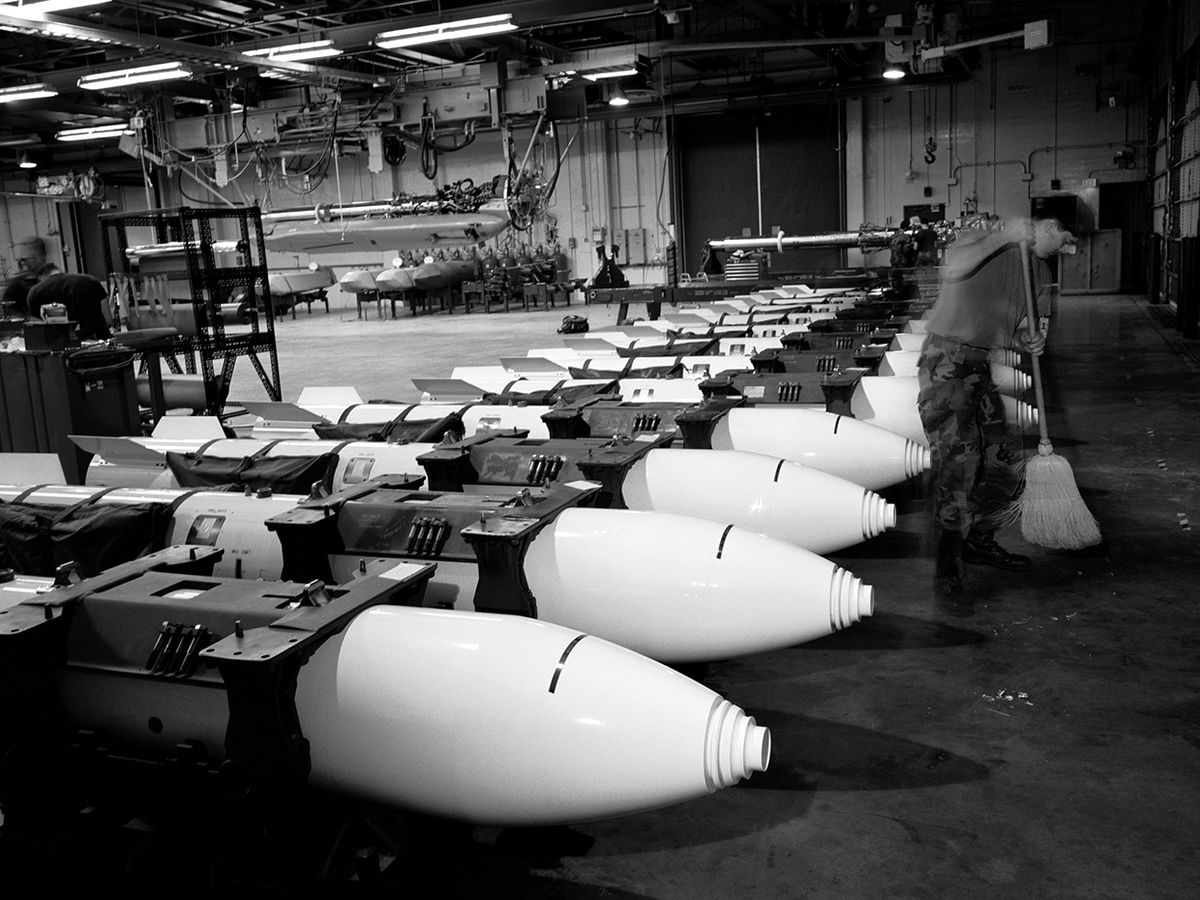
The United States’ thousands of nuclear warheads have the explosive equivalent of over 1 gigaton of TNT. It’s an amount of energy that could literally move mountains, reroute rivers, alter climate, and result in the deaths of hundreds of millions or even billions of people, through fire, radiation, and starvation.
Like everything else on Earth, those warheads are getting older. But unlike anything else on Earth, that mere aging may have profound consequences for the national security of the United States.
Most of the nuclear warheads in the U.S. arsenal date from the late 1970s and the 1980s, with anticipated lifetimes of 20 to 25 years; the most recent ones, the submarine-launched W88s, were added in 1988. Most of the warheads, in other words, are now past or nearing their estimated expiration dates. If nothing is done to maintain these hugely complex systems, they will in time fail, leaving the United States with no nuclear arsenal at all.
In fact, U.S. President Barack Obama has expressed an interest in eliminating all nuclear weapons—eventually. But he has also stated that the United States still needs a nuclear deterrent and that nuclear weapons should remain a key part of its security strategy for the time being.
Officials in the United States and the other seven declared nuclear powers are now grappling with a tricky and essentially unprecedented problem: What is the best way to sustain their nuclear deterrents? The question is particularly urgent in the United States, which has some 5200 functional nuclear warheads, about the same number as Russia, and several thousand more than the sum total of the world’s other nuclear arsenals combined.
Since the early 1990s, the prevailing view of nuclear weapons is that they are like other manufactured systems, such as cars and commercial jets. Their various components grow old, and eventually they will become nonfunctional. But that fate can be staved off by routine surveillance and maintenance and occasional replacement of parts or software. Such techniques have successfully extended the life spans of commercial airliners by decades.
But over the past several years, some high-placed U.S. officials, including Defense Secretary Robert Gates, have come around to a different view—that even with diligent inspection and maintenance, the current arsenal will soon become unreliable and will no longer have much deterrent value. The only solution, they say, is to design and build new warheads. These new weapons would be produced using state-of-the-art industrial methods that would vastly simplify manufacturing and maintenance and also drive down costs.
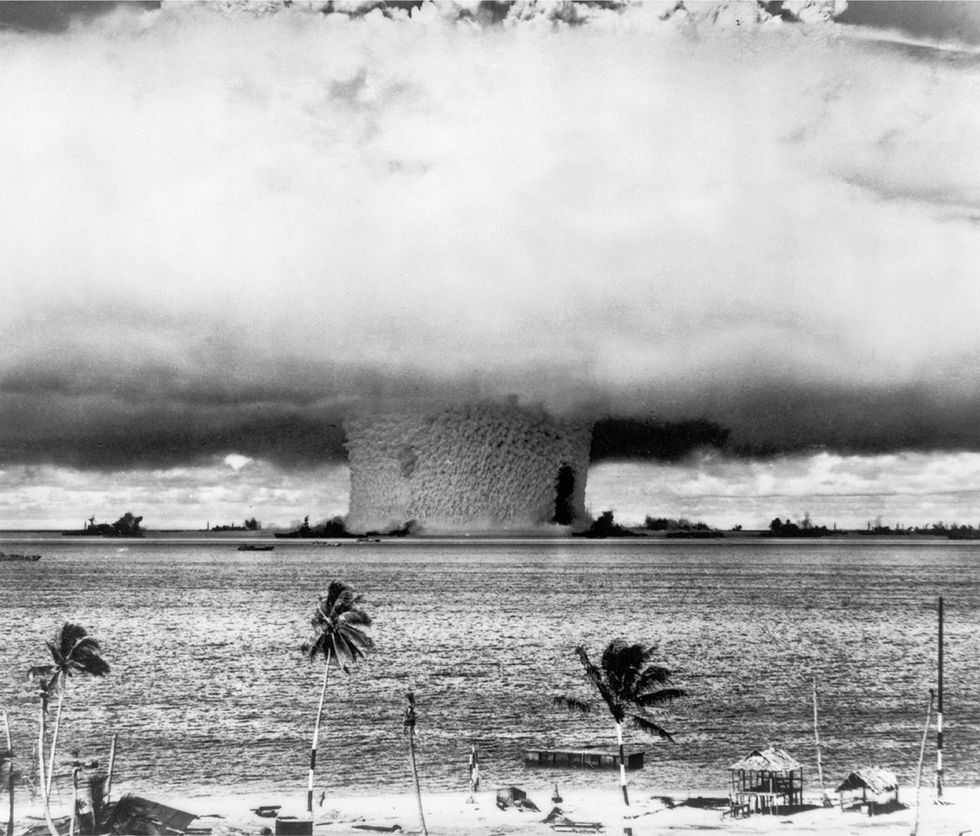
Such arguments for new warheads are compelling—but also controversial. Critics note that under the Treaty on the Non-Proliferation of Nuclear Weapons, or NPT, the United States and other nuclear nations are obligated to work toward eliminating their nuclear arsenals. Some even argue that U.S. modernization efforts, though confined so far to paper studies, have encouraged North Korea, Iran, and other countries to redouble their efforts to produce nuclear arsenals of their own. Proponents of building new warheads counter that these systems would simply be replacing antiquated weapons and that over time the total arsenal would continue to shrink.
Geopolitics is an inexact science, to put it mildly. But physics is not, and as physicists who’ve been involved in science and national security policy for many years, we believe that science and technology can, in this case at least, tell us all we need to know to decide this issue. Based on the available data, we are confident that the current program of stockpile stewardship, with some modifications, can preserve the U.S. arsenal for the foreseeable future and that it isn’t necessary—and may even be counterproductive—to pursue new warheads.
What we’re not saying is that extending the life span of the arsenal is going to be easy. To understand why, you’re going to need a quick refresher in nuclear history and technology.
The United States invented nuclear weapons during World War II and used the first ones toward the end of that war, in August 1945, when U.S. forces dropped atomic bombs on the Japanese cities of Hiroshima and Nagasaki. They remain the only nuclear weapons ever used in combat.
Not surprisingly, nuclear weapons quickly gained a central role in U.S. national security policy. A vast and secretive nuclear-weapons complex arose, with the U.S. Department of Defense dictating the military requirements that guided each new warhead design. Designing, building, testing, and stockpiling those warheads fell to the laboratories now operated by the U.S. Department of Energy (DOE)—namely, Lawrence Livermore, Sandia, and Los Alamos—and the weapons-production facilities, including Hanford, Oak Ridge, Rocky Flats, Y-12, Argonne, Savannah River, and Pantex.
Typically, the labs would produce competing designs for a new warhead, of which one would be selected. Los Alamos National Laboratory led the field: Warheads designed there now make up more than 80 percent of the active stockpile [see table, "Warheads Produced at Los Alamos"].
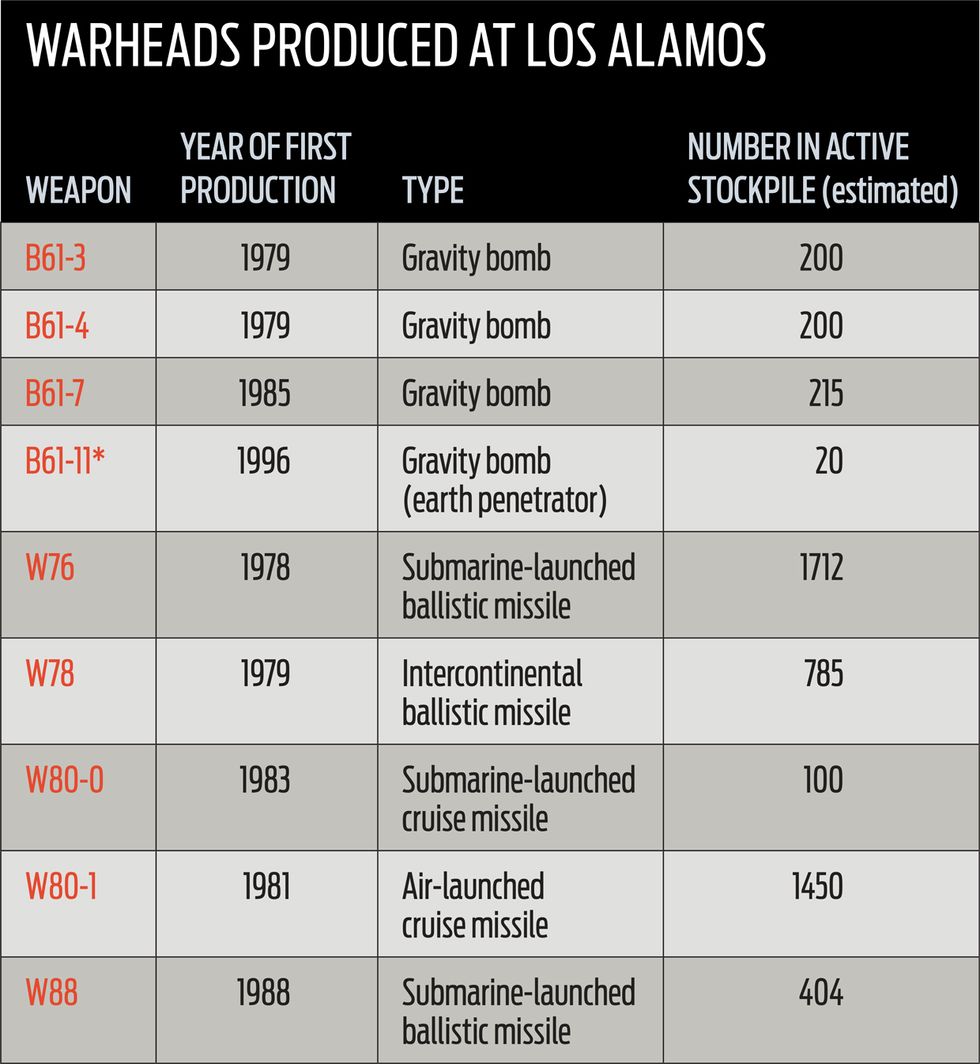
After a design was selected, the first prototypes would be assembled and tested; based on the test results, nuclear designers would refine their creations. Once a design was finalized, the weapons would be built in quantity at one or more of the DOE production facilities, with the final assembly taking place at the Pantex plant, near Amarillo, Texas.
The weapons would be deployed to the services for a typical lifetime of 20 years. (Although the U.S. Army no longer has nuclear forces, the Navy and Air Force still do.) At any given time, the number of weapons deployed or held in reserve depended on the U.S. government’s assessment of threats as well as its international treaty obligations. For nearly five decades the United States continued to design, build, and test nuclear weapons, routinely replacing older warheads with newer, more advanced ones.
As in any engineering enterprise, the testing phase was considered crucial. From July 1945 through September 1992, the country performed 1054 nuclear tests. Initially, the detonations occurred above ground, at the Pacific atolls of Bikini and Enewetak and also at the Nevada Test Site in the western United States. After November 1962, U.S. testing moved underground, at the Nevada site.
Then, in 1992, the U.S. government imposed a moratorium on all nuclear testing, which has since been extended indefinitely. Three years earlier, production of the plutonium pits that are at the heart of a warhead had been shut down at the Rocky Flats facility, in Colorado. Because Rocky Flats was responsible for the plutonium pits used in all U.S. warheads, its closure effectively ended the production of new weapons.
That left nuclear weaponeers with a difficult engineering challenge: Maintain a reliable U.S. arsenal, but do it without building or testing new warheads. The strategy they came up with is called stockpile stewardship.
Surveillance, assessment, and refurbishment are the cornerstones of the Stockpile Stewardship Program, which began in 1993. A sprawling endeavor with activities spread over facilities in seven states [see map, "Stewards of the Stockpile"], the program cost U.S. taxpayers about $6.5 billion last year. Compared to other important infrastructure programs, that’s not out of line. The U.S. government spent $195 billion to fix roads and bridges that same year.
The program’s simple-sounding name, Stockpile Stewardship, doesn’t begin to capture the enormity of the task. Very few systems are engineered to sit inactive for years or decades and then be ready to deploy at just a few moments’ notice. Bear in mind, too, that each weapon is extremely complex, incorporating chemical explosives, radioactive materials such as plutonium and tritium, an array of electrical and electronic components, and metal casings, support structures, and more. The failure of any of these would degrade the weapon’s performance.
Every year, workers in the Stockpile Stewardship Program systematically inspect 20-plus samples of each type of warhead in the active stockpile. When a problem is spotted, inspectors then decide whether a fix needs to be applied across all similar warhead types. Inspections include destructive testing of some of the nonnuclear components and nondestructive testing of other components. The exact components inspected and the exact tests performed are classified. But in general, the inspectors look for signs of aging, such as cracks or corrosion. They also use supercomputer simulations to assess the possible impact of any such deterioration on the weapon’s safety and reliability.
As you might have guessed, measuring and combating the effects of radiation on the warhead’s components is a primary focus of stockpile stewardship. All the components in a warhead are of course designed to withstand a radioactive environment; the computer chips, for example, which control the bomb’s fusing, triggering, and detonation, among other things, are all radiation hardened.
A warhead’s radioactive materials are also subject to decay. For instance, tritium, a radioactive isotope of hydrogen used in warheads to boost the explosive power, has a half-life of 12.3 years and so must be replaced at regular intervals.
Plutonium-239, the isotope used in nuclear weapons, is a little more hardy; it has a half-life of about 24 000 years. In a weapon, the plutonium is arranged in a grapefruit-size “pit.” When a thermonuclear weapon is detonated, chemical high explosives produce a collapsing shock wave that physically compresses the hollow spherical pit. The pit achieves critical mass and, with the help of a neutron generator, begins a runaway fission reaction. The chemical explosives, the pit, and the initiator are collectively known as the weapon’s primary. The primary’s fission reaction, in turn, produces the extreme temperature and pressure needed to trigger the thermonuclear (fusion) reaction, in the part of the weapon called the secondary, where virtually all the explosive yield of the bomb comes from [for further details, see sidebar, "How Nuclear Weapons Work"].
How Nuclear Weapons Work
The critical component of any nuclear weapon is the fissile material. This can be highly enriched uranium or plutonium. For the uranium in particular, the material’s isotope is crucial. (Recall that the number of neutrons in an atom’s nucleus determines the isotope.) For a fission bomb, the most suitable uranium isotope is U-235. For plutonium it’s Pu-239.
In a fission reaction, the isotope’s nucleus is struck by a neutron and splits into two smaller pieces, releasing both energy and additional neutrons. With enough fissile material in a sufficiently compact volume, those additional neutrons will strike other nuclei, causing them to undergo fission and start and sustain a chain reaction.
The nuclear bomb dropped on Hiroshima was a gun-type device, which shot a subcritical mass of uranium into another subcritical mass of uranium; the combination of the two created a supercritical mass. The warhead dropped on Nagasaki, by contrast, was a somewhat more sophisticated implosion device. In this bomb, a conventional high explosive surrounding a plutonium core was detonated, compressing the core and increasing its density. The compression caused the critical mass to be exceeded and, again, a fission reaction resulted. Both bombs used a neutron generator, which releases enough neutrons to kick-start the chain reaction.
A key advance in warhead design came in the early 1950s through the addition of a small amount of a light element, such as lithium or tritium. Known as boosting, this addition causes the plutonium or uranium fuel to burn more completely, increasing the yield of the weapon.
Today’s nuclear warheads are known as thermonuclear devices and operate in two stages. In the primary stage, implosion of the boosted plutonium generates enough X-ray energy to ignite a second, much more powerful boosted weapon in the secondary stage.
Throughout the Cold War, the goal for each successive generation of warheads was always to increase the destructiveness of the weapon—known, perhaps euphemistically, as the yield and measured in equivalent tons of TNT—using the same warhead mass. The two weapons used in World War II, for example, had yields of 13 to 21 kilotons of TNT equivalent. In the 1960s the Soviets tested warheads equal to 50 megatons of TNT. —F.S & B.T.
Scientists used to worry that radioactive decay of the plutonium pit would shorten its useful lifetime. A half-life measured in tens of thousands of years would seem to preclude immediate concern, but the sample does sustain very slight damage each time a plutonium atom decays. That decay releases an alpha particle that slightly displaces a few thousand other plutonium atoms from their original locations. The concern was that these relocations would change the grain structure of the plutonium metal, thereby diminishing its explosive power.
But extensive studies of pits using high-resolution imaging techniques, such as transmission electron microscopy and X-ray photography, and accelerated aging studies using shorter-lived isotopes of plutonium have revealed no significant aging problems. Indeed, based on these findings, a 2007 report by JASON, a distinguished and high-level defense advisory group, concluded that “most primary types have credible minimum lifetimes in excess of 100 years.”
Think of an aging weapon as an aging car. Several weapons experts already have, including Stephen M. Younger, president of National Security Technologies, which oversees the Nevada Test Site. In a 1999 paper, he wrote, “Cars age. Materials need to be replaced and batteries wear out. You need to do all sorts of things. Each component has a finite life, although with proper attention the whole system may last for a long time. We have the same situation with nuclear weapons.”
Much like an aging sedan, aging warheads undergo regularly scheduled refurbishments and upgrades to correct any problems spotted during the inspections.
In some cases, a replacement part that no longer exists may need to be remanufactured. Or the manufacturing processes used to produce the part may now be considered too hazardous, such as those involving beryllium, which can cause skin and lung disease. In those instances, specialists need to design a new component and then fabricate it using safer tools and techniques. Still other aging components may be replaced with modern parts. To this day, some weapons still contain vacuum tubes; workers replace these with solid-state electronics.
But not everyone is convinced that the Stockpile Stewardship Program’s annual inspections are effective. Especially in the last three years, a number of people at the weapons labs and the National Nuclear Security Administration, which oversees the stewardship program, have raised concerns about its long-term viability. The associate directors of the Los Alamos and Lawrence Livermore laboratories and the vice president of Sandia National Laboratories have all called for a return to designing and building new nuclear weapons, under a program they call the Reliable Replacement Warhead (RRW).
Technology has come a long way since the last U.S. nuclear weapons were designed in the mid ’80s. For that and other reasons, new weapons built under the RRW effort would be vastly superior to the current stockpile, proponents argue. Their designs would emphasize safety, security, and reliability, rather than just maximum explosive power. The new warheads would also be simpler and cheaper to construct and maintain, and they would allow for the use of modern manufacturing techniques, rather than the comparatively costly and dangerous processes used during the Cold War. The RRW program would also train a new generation of U.S. weapons designers.
After considerable debate, the Nuclear Weapons Council, which consists of senior officials from the departments of Defense and Energy and the Joint Chiefs of Staff, threw its weight behind the concept in 2005. It authorized a design competition between a New Mexico–based team (with members from Los Alamos and Sandia’s Albuquerque division) and a California team (from Lawrence Livermore and Sandia’s California division). Of the two preliminary RRW designs, it selected the California one, and Lawrence Livermore was tapped to prepare a final design, called the RRW-1. The RRW-1 warhead is intended to replace the W76, a thermonuclear device carried by submarine-launched ballistic missiles; the last W76s entered the stockpile in 1987. The plan also called for a full-scale engineering design of the new warhead, with initial operational capability by 2012.
From 2004 to 2007, Congress funded the RRW concept but imposed a number of restrictions. It required that the RRW be developed without any nuclear testing and that it lead to a smaller overall stockpile. Congress also mandated that the RRW fulfill only current mission requirements, as defined by the Defense Department, contain improved safety and security attributes, and save money.
But adhering to those restrictions hasn’t been enough to guarantee the future of the RRW. For the past two years, Congress has refused to fund it. Meanwhile, the Obama administration has stated that it will not pursue new nuclear weapons. Even so, Defense Secretary Gates has repeatedly voiced his strong support for the program’s continuance, most recently in an article in the January/February 2009 issue of Foreign Affairs.
With a decision still pending, it is worth asking: Is a new nuclear weapon necessary? We think the answer is no.
To understand why, first consider how defects accumulate in a complex system. Most such systems, including nuclear warheads, follow a Weibull curve, also known as a bathtub curve, that characterizes the rate of defects it will suffer over time [see graph, "In the Tub"]. The curve has three distinct parts: 1) a high rate of “birth defects,” which gradually decrease over the early period of the system’s life; 2) a quiescent, relatively trouble-free period as the system matures; and 3) an “end-of-life” wear-out period marked by a rise in defects, requiring parts to be fixed or replaced frequently. When a system is in its end-of-life phase, the amount of maintenance and repair required to keep it operational becomes burdensome.
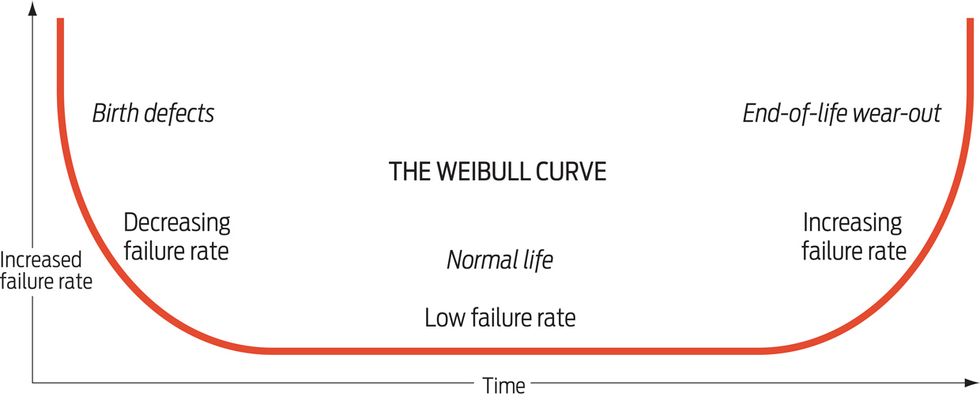
In nuclear weapons circles, these defects are referred to as findings, with more serious defects called significant findings, or SFIs. Under Stockpile Stewardship, SFIs are closely monitored. When an SFI is first identified, it is referred to as open; the SFI is considered closed when a solution has been determined, although not necessarily implemented. In general, most findings are due to aging in the nonnuclear part of the warhead and are relatively easily fixed. Some, though, require more involved intervention, including the design and manufacture of replacement components.
The best way to track the aging of warheads is to chart the SFIs over time. The weapons labs do this, of course, and their data show that for the arsenal as a whole, the failure rate is still low. For example, the graph “Old but Okay” shows that only a few age-related SFIs have been reported in nuclear components over time, even in the oldest systems. Other data for 2005 and 2006, the most recent years for which data are publicly available, indicate that the number of new SFIs had declined to the lowest level since the start of the stewardship program. But it’s also taking longer to resolve open SFIs; in 2006, it took an average of 70 months to close an SFI, compared to 40 months in 2005.
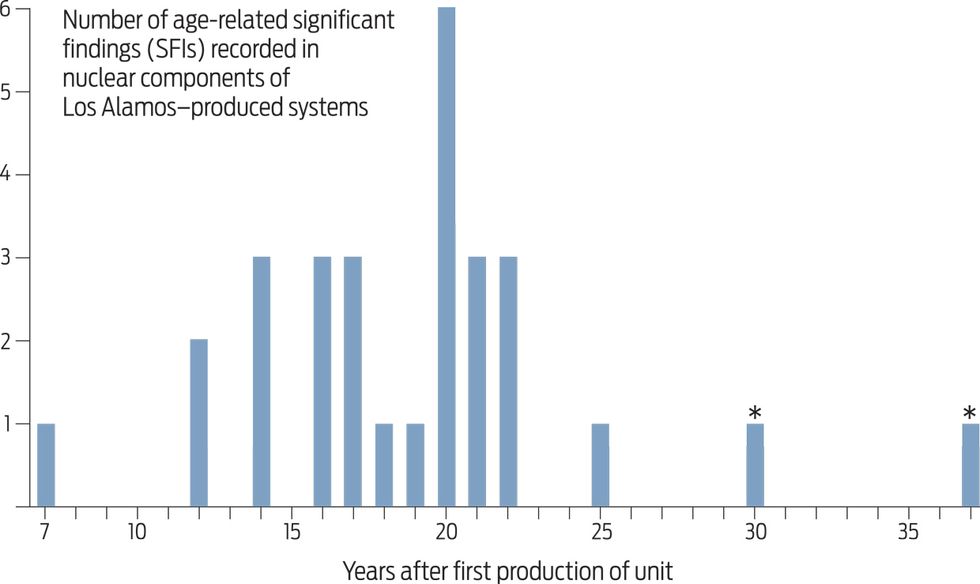
Based on the SFI data, we can draw two hopeful conclusions and one somewhat ambiguous one:
- The Stockpile Stewardship Program is successfully detecting defects.
- The program is effectively addressing them.
- As time goes on, it is taking longer to find a solution to a given defect.
The first two points suggest that stockpile stewardship is doing what it was designed to do. In particular, the number of open SFIs at the end of 2006 was the lowest in 10 years.
The third point, that it’s taking longer to close SFIs, has several possible explanations. We can’t know for sure which is correct, because the details of the SFIs are classified. It may be that the defects are presenting substantial and growing challenges. Or it may simply be that the labs don’t have enough workers, or workers with the right experience, to resolve the problems quickly. In any case, it is not the nature of the defects but the rate at which defects emerge that indicates where a system is on the Weibull curve.
So is the existing stockpile now reaching the end of its Weibull curve? It doesn’t look that way to us. Assuming that nuclear weapons age just like any other manufactured system, then as the weapons enter the end-of-life phase you’d expect to see a significant uptick in SFIs. But the data clearly indicate that no such rise is occurring—even in the oldest systems that have already exceeded their design lifetimes. Although there is a spike in the number of SFIs at the 20-year mark, no system older than that has exhibited a trend of increasing SFIs. Indeed, among the five nuclear weapon types in the active stockpile that were at least 25 years old in 2006—the B61-3, B61-4, W76, W78, and W80-1—only one age-related defect in nuclear components was detected. Further, other stockpile data show that SFIs are infrequent even for systems that are more than 30 years old.
Suppose, though, for argument’s sake, that the active stockpile is going to reach the end of its Weibull curve in the near future. Even then, that doesn’t mean switching to a new warhead is the way to go. For one thing, any new system would also be subject to the Weibull curve; that is, it would experience a significant number of defects during its early years. Proponents of RRW argue that the new designs would be easier to fix and simpler to maintain and pose fewer technical challenges than the warheads they would replace. At this point, there’s no way of knowing if those claims are true.
Proceeding with a new nuclear weapon would also likely reduce funds for stockpile stewardship, especially in the current economic climate. Diverting resources from stewardship to the development of a new warhead could lead to a backlog in surveillance, and it could also prolong the time it takes to close SFIs. The result would be diminished confidence in the existing systems.
For all these reasons, we don’t favor switching to a completely new warhead. But there are elements of the RRW approach that may be worth considering and that could be incorporated into the existing program of stewardship. In particular, components that age rapidly could be replaced with newly designed parts that allow increased security and are easier to manufacture. For example, inserting wireless microsensors into or onto these new components would allow in situ monitoring and diagnostics and prevent having to disassemble systems for inspection. Instrumenting every active weapon in this way—rather than just inspecting a relative handful of each weapon type each year—would yield much more useful data about age-related problems.
There are many other options for maintaining the existing arsenal that have yet to be fully explored. One strategy is to reuse more of the components taken from previously tested, disassembled weapons. Another approach is to make more substantial improvements in aging components than is currently done. Of course, any such changes would take time to implement, so it’s worthwhile to explore these options now. While the stockpile is undoubtedly aging, it doesn’t appear to be close to the end of its useful life. That means there is still time for a careful evaluation of technical options for maintaining the nuclear deterrent, without having to resort to building entirely new warheads.
About the Authors
FRANCIS SLAKEY and BENN TANNENBAUM are Ph.D. physicists who now work on science and technology policy in Washington, D.C. Slakey is the Upjohn Professor of Science and Public Policy at Georgetown University and associate director of public affairs for the American Physical Society. Tannenbaum is the associate program director of the Center for Science, Technology and Security Policy at the American Association for the Advancement of Science.
To Probe Further
The JASON January 2007 study of plutonium pit lifetimes is at https://www.fas.org/irp/agency/dod/jason/pit.pdf.
For a discussion of the Weibull curve, see https://www.weibull.com/hotwire/issue21/hottopics21.htm.
More information on the Annual Assessment Reports prepared by the directors of the DOE weapons labs is available at https://www.gao.gov/htext/d07243r.html.
